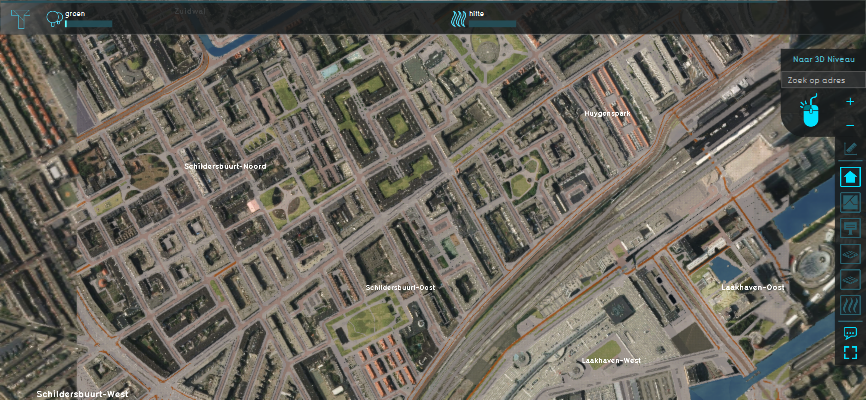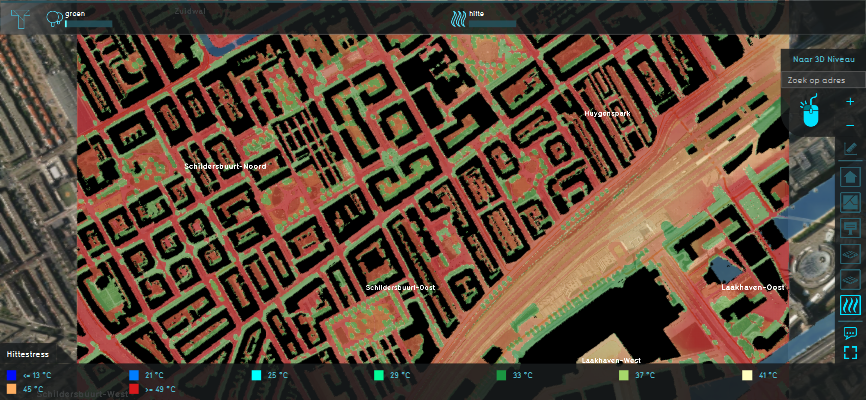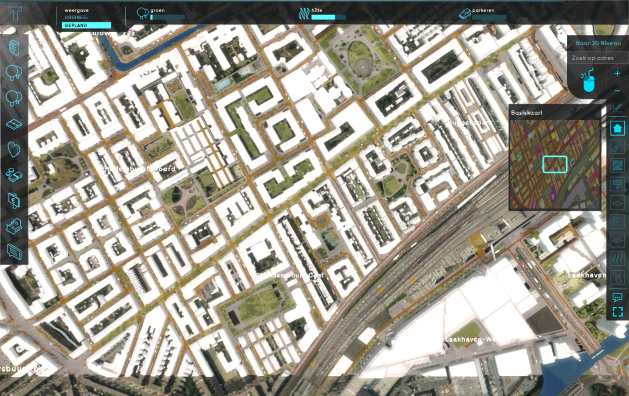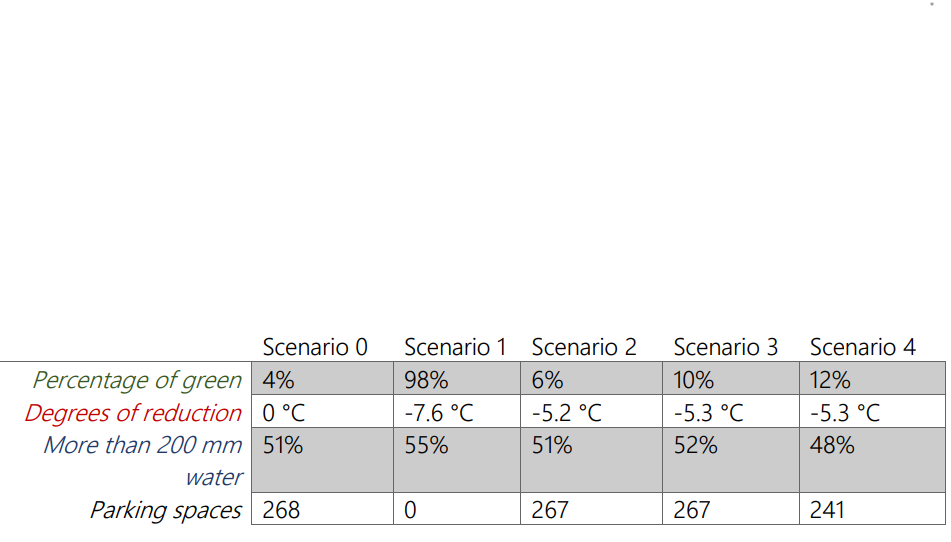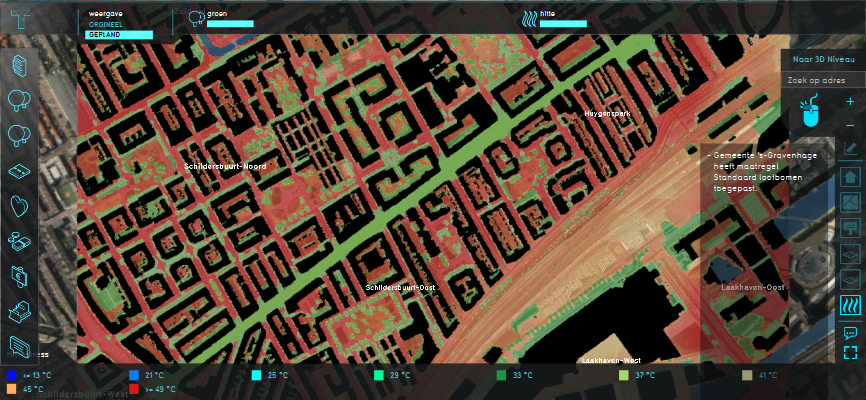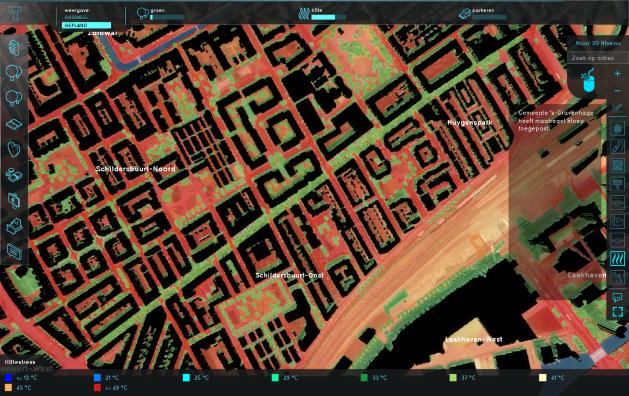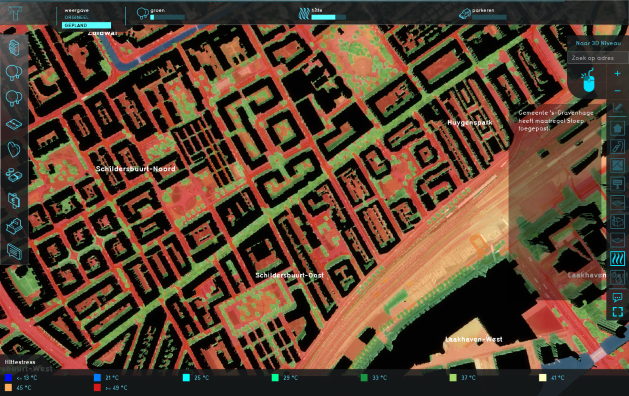Tygron for Spatial Planning
Use-case 3: “Proposals for a Greener Hoefkade”
For their sustainable development minor, a group of 4 students of different backgrounds were assigned to use the Tygron platform last year (2020) in order to develop a consultancy plan for the municipality of the Hague. This assignment was for an area study course at the University of Leiden. Their research question was "How can more greenery and other climate adaptation measures be incorporated into the Hoefkade to mitigate heat stress and flooding while taking into account the opinions of residents and local employees?". In 4 weeks only, and without any prior knowledge of the Tygron platform, the team learned how to use Tygron and created a full advisory plan for a greener Hoefkade neighbourhood in collaboration with the Municipality of the Hague. They focused on the effects of greening on heat and water.
Content of the course
General information
- Name of the course: "Area Study Sustainability Netherlands"
- Study Programme: Sustainable development (interdisciplinary minor)
- Educational Institute: Faculty of Science of Leiden University
Target students
- This course is designed for students who have already followed the Big Issues New Answers and Resilient Cities courses.
- The students have limited prior experience with ArcGIS, but are not required to know the platform.
- Students had no prior knowledge or accessibility to the Tygron platform.
- This course is delivered every year for around 30 students.
- Students are expected to work alongside a representative from the municipality.
- Students can choose qualitative or quantitative approaches.
- Students come from very different backgrounds.
The students who were chosen to work with the Tygron platform have the following backgrounds:
- Annemiek de Looze: International Studies
- Jos van der Sterre: Molecular Science & Technology / chemistry
- Veerle Cannemeijer: International Relations & Organisations
- Max van Beek: Molecular Science & Technology / chemical engineering
Objectives and desired outcome
This course aims at:
- exploring a real-world and current sustainability challenge in a local city.
- putting into practice the acquired theories and methods.
- analyzing the area challenges, solutions and the factors that obstruct these solutions.
The main objective is for students to act as sustainability experts to provide sustainability advice to the City Councils of either Leiden or The Hague, based on their sustainability goals.
The main component of the course is interdisciplinary group work, which is crucial to resolving sustainability challenges.
The expected (group) outcome of this course is:
- a consultancy report that provides recommendations for a better implementation of the goals set by the city councils.
- a contribution to a blog.
- a final presentation of the findings.
Design of the Course
Syllabus and time distribution
- The course is full time and spread over 4 weeks.
- There are 7 credits assigned for this course.
- During the course, there are lectures to provide additional content regarding the themes under study.
- During the course, excursions are organized to provide context on sustainability.
- Excursions are not related to the assignment. Last year (2020), students were taken to Tata Steel and to a waste incineration plant.
- Besides the excursions and the lectures, the rest of the course is self-monitored.
- Students are split into groups of 4-5 students and each group is assigned a different study area.
- At the end of the course:
- working groups submit their advisory reports.
- they showcase their results through group presentations during a final lecture.
Using the Tygron platform
As an experiment, last year (2020) one of the working groups was chosen to work with the Tygron platform for this assignment.
Their research focused on the effects of green spaces on heat stress, flooding, and livability in the Hoefkade, the Hague.
They used a scenario approach, where they compared quantitatively the effect of each scenario on the neighbourhood focusing on the heat and flooding indicators.
In 4 weeks, students had to learn the Tygron platform, conduct interviews with locals, and produce a consultancy plan that takes into account the city council's current redevelopment plan.
Guidance and Resources
This section is from the perspective of the working group that was using the Tygron platform.
- In day 1, students are split into groups. Each group chooses a study area.
- In day 2, the team who choose heat & flooding in the Hoefkade was asked to use the Tygron platform for their assignment. They downloaded the platform.
- In day 4, the team visited the Tygron office in the Hague and were given a demo explaining how the software works.
- After that, the team started working with the Tygron platform after watching some video tutorials.
- To make it easier, the team split into 2: 2 of them conducted interviews with residents of Hoefkade, and 2 were focusing on the configuration of the model in Tygron.
- It took the students around 1.5 weeks to get used to the platform.
- In the third week, everything went very quickly after all the scenarios are implemented in the platform.
- In the last few days, students focused on making the report and delivering the presentations.
- Team members used their own laptops. One group member used his computer because it was faster.
- A challenging aspect was translating the municipality plan into objects in Tygron.
- Students did not receive any direct support from Tygron during their assignment. However, they used the community forum to ask technical questions.
- Functions that were used mostly in this assignment:
- Heat stress overlay
- Water overlay
- Indicators: green space, the reduction of heat stress, the reduction of water stress, and the number of parking spaces in the Hoefkade.
- Measures
Outcome of the course
- To answer the main research question, the students developed five different scenarios to compare in the Tygron platform:
- Scenario 0: the current situation
- Scenario 1: the all green scenario
- Scenario 2: the current redevelopment plan
- Scenario 3: Scenario 2 + more green spaces
- Scenario 4: Scenario 3 + more water storage interventions
- The scenarios were implemented to test the effects of different greening plans on flooding and heat.
The team was able to conclude that:
- the current plans for the Hoefkade (scenario 2) will already prove to be effective and will reduce the heat up to 5,2°C.
- adding even more greenery will only reduce the heat by an extra 0,10°C.
- out of all-green measures, trees are the most effective in reducing the temperature.
- while greenery proved to be the perfect solution in decreasing heat, it did not sufficiently reduce the problem of flooding.
- an effective solution for flooding is water storage tanks and permeable bricks.
- The performance of the working group was very good.
You can read the group's full report here: File:A-Greener-Hoefkade.pdf
Feedback and recommendations
Based on their experience with Tygron last year (2020), the students recommend the following:
- Learning and using the Tygron platform for 4 weeks was possible but very challenging. It is recommended to make the course longer unless it is used for something other than consultancy such as research.
- In this course, some groups were focusing on a neighbourhood level and some were focusing on a larger area. It is recommended to have areas that are similar in size for different teams.
- Include some lectures about the platform, including useful tips and tricks, which would make the course go smoother.
- Choosing a smaller area, so that the software runs easier on weaker laptops.
- Working offline in a classroom setting, especially if the assignment is a group project.
- Including real stakeholders in the project; students get excited if their proposal could potentially be implemented.
"Tygron really brought our project to life. It was very interesting to be able to directly see the consequences of our ideas in the program. With Tygron we were able to make very concrete scenarios and that gave our project a lot of added value. We, therefore, hope that the municipality can do something with our findings to make the Hoefkade a bit more beautiful and sustainable." Annemiek de Looze & Veerle Cannemeijer – from the Hoefkade team
Contact
For more information about this course, you can contact us at:
You can also reach Max van Beek, a member of the working-group that used the Tygron platform for this course:
Course Lecturer: Benjamin Sprecher
| <<Previous page | Next page>> |
